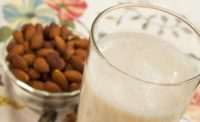Tackle flavor issues associated with plant-based dairy alternatives








If William McCormack, business development manager for nutrition at Wauconda, Ill.-based Synergy Flavors, noticed anything at the recent Natural Products Expo West in Anaheim, Calif., it’s that the current fad for plant-based dairy alternatives is anything but a fad.
“A casual walk-through the event would likely convince even the biggest skeptic that plant-based dairy alternatives are here to stay,” McCormack said. “We anticipate that very shortly, this segment will no longer be an ‘emerging’ category, but will be considered established within the broader food and beverage space.”
You could argue it already is. According to London-based Euromonitor International, the dairy alternatives sector is poised for volume and value growth of 4.9% and 6.2%, respectively, through 2023 (compound annual growth rate). And you don’t need a market research report to tell you that mainstream dairy cases are giving more real estate to nondairy substitutes.
Yet despite having so much going for them, plant-based products can’t afford to coast — because if there’s one thing that could hold them back, it’s flavor: Plant-based dairy alternatives can taste strange, especially relative to the clean, mild dairy profiles they aim to replicate.
But with oat “milk” and cashew “cheese” giving the real things a run for their money, somebody must be doing something right. So we sat down with flavor experts to find out what.
Demand you can’t ignore
“We can report anecdotally that we’ve seen a marked increase in customer requests related to plant-based dairy alternative formulation,” McCormack said.
Logan Cisewski, research, development and acquisitions scientist for Kerry, Beloit, Wis., has seen a dramatic uptick in plant-based dairy alternative projects over the past couple years, too.
“A large portion of the dairies we work with are starting to dedicate line time and new product development to plant-based alternatives,” he said. “That in and of itself tells us that the industry is expecting demand for these products to continue.”
When Tracy Snider, marketing manager for St. Louis-based Balchem Ingredient Solutions, was mapping ice cream and frozen dessert trends for the company’s annual Feature Flavors launch, she and her team pegged dairy alternatives as a market trend to watch going into 2020.
“Plant-based product claims had increased by 62% globally from 2013 to 2017, according to Innova Market Insights data,” she noted. “And over just the past two years, U.S. consumers have increased their plant-based milk and yogurt consumption. All these numbers add up to a market you can’t ignore.”
Colonizing the case
As do the facts on the ground.
“I think it’s safe to say that if it’s in the dairy section, someone somewhere is trying to make a plant-based version of it,” Cisewski declared. “We’ve seen it all.”
Zeynep Taksin, senior marketing manager for Citromax Flavors, Carlstadt, N.J., has also noticed plant-based applications colonizing the main dairy shelves.
“And we’ve worked with plant bases from legumes like peas and grains like rice and oats to nuts — almonds, cashew, hazelnut, peanut, macadamia — and options like flaxseed and coconut,” she said. “It’s certainly not only soy-based anymore.”
Philip Caputo, marketing and consumer insights manager for Virginia Dare, New York, said oats and peas are actually moving in on soy, almond, coconut, hemp and rice because they have a more neutral flavor profile, a smooth texture and a creamy mouthfeel.
“And expect more sprouted nuts, grains and seeds,” he added.
Caputo has witnessed palpable improvement in the quality of dairy alternatives, too.
“Vegan ice creams finally taste great thanks to improved plant-based formulations,” he noted. “Expect this category to continue expanding.”
And Caputo thinks plant-based creamers will trade on their functional and vegan bona fides to gain ground on more traditional options in the coming years.
Bigger tent
“The fact that these products have received a lot of buzz not only as healthy options, but as good-tasting ones, too, has led more consumers to willingly give them a try,” observed Shannon Cushen, director of marketing, Fuchs North America, Hampstead, Md.
This widening pool of consumers proves that the plant-based sector has room for all.
“It’s not just those with dairy allergies or vegans adopting these products into their diets,” Cushen said. “Now it could be just about anyone: curious consumers, those seeking what they perceive as healthier options, people concerned about sustainability and the environmental impacts of dairy farming. That’s what indicates that this trend is here to stay.”
Caputo believes it reflects a longer-term shift driven by “the conscious, enlightened and emotionally invested consumer.” The expansive variety of plant-based dairy alternatives can now cater to a wide range of consumer concerns, including individual health decisions, allergen issues, environmental considerations, animal wellbeing and more.
When it comes to the health benefits of dairy products vs. plant-based alternatives, perception often trumps reality.
“Many believe nondairy milk is just as good as or even better for you than dairy milk,” said Steven Spreenberg, marketing specialist for Flavorchem, Downers Grove, Ill. “According to a 2018 DMI report, 42% of buyers think plant-based dairy is more nutritious than or equally nutritious as dairy milk, and only 20% say that dairy milk is more nutritious.”
And on the environmental comparisons, McCormack noted that nondairy options are also viewed by some, without substantiation, as being more natural and sustainable.
“But at the end of the day, it’s about giving consumers a wide range of choices, both dairy and nondairy,” he said.
The catch
All things considered, Keera Perumbala, marketing associate for Hoffman Estates, Ill.-based Sensient Flavors, sees two camps gravitating toward the plant-based space.
“One is the hardcore vegan who pursues veganism for strict health reasons, religious beliefs or some other nonnegotiable,” she said. “The others are the vegan explorers — consumers who’re perfectly OK eating dairy but choose to test the plant-based waters out of culinary curiosity or to complement their holistic health pursuits. And it’s this consumer who’s definitely not willing to compromise on taste.”
Alas, taste is the most noticeable shortfall plant-based alternatives exhibit vis-à-vis their dairy counterparts.
“Plant-based alternatives typically have naturally green, earthy and vegetative attributes, which make formulating with these bases more difficult than with dairy,” McCormack said. “In addition to the flavor drawbacks, the texture of plant bases can be challenging and contribute to an overall negative organoleptic experience. For example, rice protein has a naturally gritty texture that may not be as appealing as the creamy texture of whey, possibly presenting some formulation challenges.”
Making matters worse, Caputo added, is high-temperature processing, which can exacerbate textural problems, especially in mouth-coating beverages.
The breaking point
These downsides aren’t necessarily death blows for dairy alternatives.
“Some daring consumers will accept the grainy, bitter off-notes from these plant sources, as they fit the better-for-you perception,” said Rebecca Sowa, sweet innovation scientist for Sensient. “More mainstream consumers, though, will force the products to mimic what’s familiar and on the market today.”
Comax Flavors, Melville, N.Y., conducted a survey in July 2017 on the nondairy product consumption habits and preferences of 1,000 American consumers ranging from age 18 to 70-plus. Among the survey’s findings was that flavor tops all attributes driving purchase for all age groups. It was also the most important driver for nondairy creamer and frozen dessert purchases, and the second-most important for nondairy milks and yogurts. So: Flavor matters.
This is certainly true for flexitarians, who want plant-based alternatives to have a taste and texture as close to real dairy products as possible, said Catherine Armstrong, brand ambassador for Comax. But she believes that as plant-based flavor profiles improve, even hardcore vegans will get pickier.
In the end, McCormack suspects that flavor can be an impediment to repeat purchase.
“If a flavor profile doesn’t resonate, consumers will be less likely to purchase the product again. While the desire to make healthy choices tends to drive modern purchase habits, taste remains king,” he said.
Work with me
That’s why the most pressing issue for plant-based formulators remains nailing an appetizing taste profile.
“Heavier flavors like chocolate and coffee can help cover plant-based flavor flaws, and traditional flavors like vanilla can mask off-flavors,” noted Dan Fox, director of sales for Nielsen-Massey, Waukegan, Ill.
He sees vanilla, in particular, as an asset.
“We use a proprietary slow cold-extraction process that gently draws out and preserves more than 300 flavor compounds, resulting in the highest-quality vanilla that can enhance plant-based dairy alternatives,” he said. “Our extracts act as flavor enhancers and help meld flavors together in a variety of plant-based applications, including ice creams, puddings, custards, yogurts and milks.”
Sowa agrees that flavors such as chocolate, caramel and vanilla add richness and build “robust layers of complexity” that mask off-notes from plant bases.
“Many fruit flavors need acids to boost distinctive juicy fruit characteristics, which might not work with the plant-based milk formulation,” she said.
The exception is coconut milk, which has natural fruity notes that can actually enhance fruit profiles in ice creams and yogurts.
Know your base
By teaming plant-friendly flavors with flavor-masking technologies, formulators “allow for unique, intricate solutions to plant-based off-notes,” Sowa said. But such solutions aren’t one-size-fits-all, and new plant proteins bring new challenges.
“Flavors and masking technologies are constantly evolving and expanding to cover the changing list of plant-based sources,” she said.
And that underscores a maxim that McCormack advocates for plant-based formulation: Know your base.
“Typically, dairy alternatives are a combination of different protein sources,” he said. “As such, the flavor solution will ultimately depend on the type and ratio of those sources.”
Molecular analysis helps identify the precise compounds responsible for a base’s off-notes, better enabling the flavorist to develop a targeted solution. Sensory science also helps flavorists understand how plant bases interact with bitter, salt and sweet receptors, further equipping them to identify the negatives while accentuating the positives.
“As an example, a customer came to us with a challenging nondairy ready-to-mix protein powder that contained a blend of pea, rice and hemp proteins and had a particularly green and vegetative profile,” McCormack explained. “Using a combination of gas chromatography-olfactometry and sensory science, we analyzed the base to understand the volatile compounds that were contributing to the aroma.
“Once we understood these compounds, our flavor chemists developed a masking system to minimize the impact of the offensives notes and a flavor system that would complement, and in some instances accentuate, the favorable notes inherent in the base,” he added.
Flavor early and often
Beth Warren, chief commercial officer with The Edlong Corp., Elk Grove Village, Ill., also advises knowing your base, adding that addressing plant-based flavors early in the product development cycle — rather than scrambling to mask them at the end — also serves formulations well.
“By optimizing profiles throughout the process,” she said, “innovation timelines can be accelerated.”
Case in point: a vegan vanilla ice cream Warren’s team built from a pea protein and coconut base.
“We had to start with flavors at the beginning of formulation to bring the plant base to ‘neutral,’ finding the right balance of ingredients to substitute for milk and cream and building a flavor profile that mimics dairy,” she recalled.
And they had to do all of this while accounting for the variety of components — carboxylic acids, esters, alcohols, furanones and lactones — that also influence flavor.
“Once our authentic dairy-free flavors were added,” she said, “the profile had significantly increased sweetness, vanilla, butter, brown caramelized and marshmallow attributes with an indulgent mouthfeel — masking the off-notes from the pea protein completely.”
Another example of savvy flavoring in action comes from Balchem, which included a frozen vegan banoffee dessert in its 2002 Feature Flavors launch. A riff on the British banoffee pie — a blend of bananas, cream and toffee on a cookie crust — the dessert began with a vegan almond-toffee frozen base in a vegan banana mix, Snider explained.
“We then created a vegan caramel variegate and swirled that in with Moroccan-spiced praline pecan inclusions, using all-natural flavors and colors,” she continued. The concept breaks ground in that instead of masking the flavors of the formulation’s dairy alternatives, the team “used them in the dessert concept to build on what we were targeting,” she said.
Steve McGowan, senior food scientist with Balchem, said the company was working to create a base that didn’t have an allergen statement when it started with the banana.
“There are so many flavors that complement or cover banana, too, so the options were tremendous,” he said. “And we know that machinery in dairies is engineered for specific viscosity and Brix levels and worked to create a base that worked within those parameters for correct overrun levels. It was a challenge, but not insurmountable, and and, with the right engineering, out.”
With the right flavors, it even tastes great.
Looking for a reprint of this article?
From high-res PDFs to custom plaques, order your copy today!









